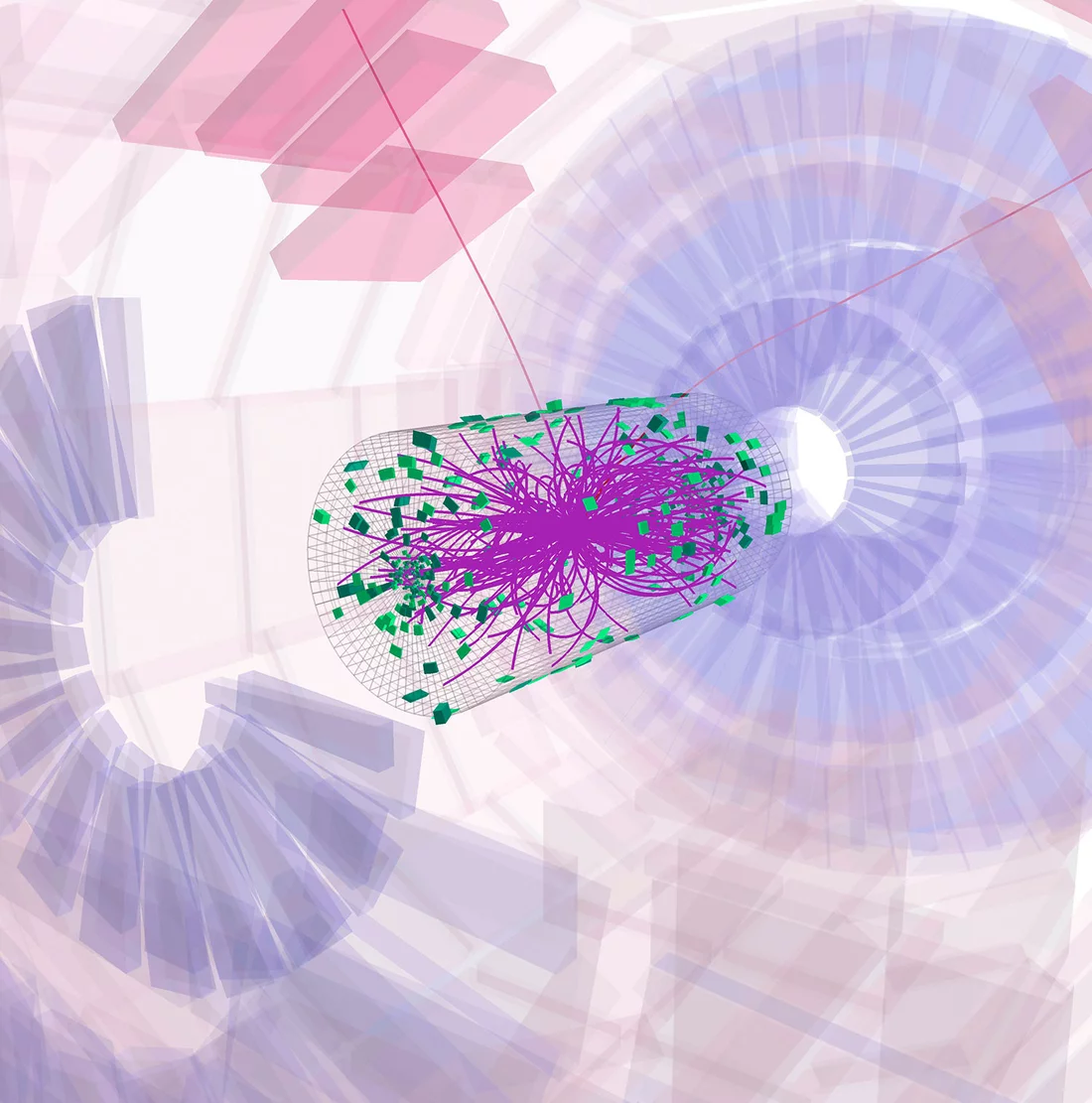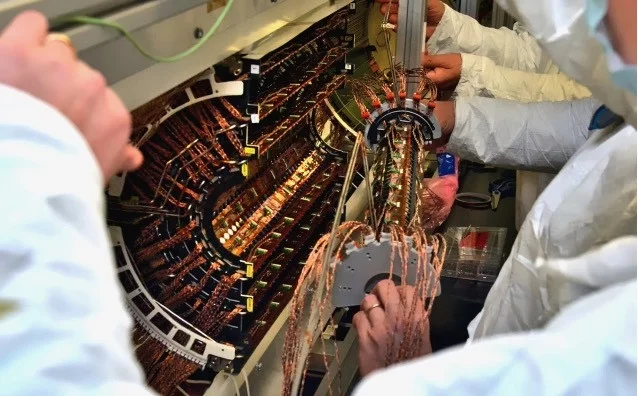The heart of the Compact Muon Solenoid detector, built and developed at PSI, is producing data again at CERN following an upgrade during the long shutdown of the Large Hadron Collider. The new period of operation with improved detector performance is set to deepen our understanding of the Higgs boson and extend the search for physics beyond the Standard Model.
The barrel pixel detector can boast a famous lineage. Developed by the High Energy Physics group at PSI for the Compact Muon Solenoid (CMS) experiment at CERN, which today is a collaboration of approximately 5500 scientists and engineers, the first model contributed to the discovery of the Higgs Boson and led in 2007 to the spin-off company DECTRIS, which now fabricates and sells X-ray detectors all over the world. Detector advances are essential to match accelerator advances at the Large Hadron Collider (LHC) and in 2017, the PSI team installed a new model in CMS, which they have now further upgraded.
The LHC resumed operation on the 5th July 2022 after a 3 year shutdown. Now, with roughly 1000 million protons colliding every second at the CMS experiment, it is clear that the detector upgrade was a success: 98.5 percent of the detector’s mindboggling 124 million pixels are working, compared to 93.5 percent before the upgrade. “We were confident that its performance would meet our expectations, but after so much work it’s fantastic to be getting data again,” says Lea Caminada, head of the High Energy Physics group at PSI, who herself contributed as a PhD student to the very first barrel pixel detector built at PSI.
124 million pixels at the centre of the action
The colossal CMS detector – 15 metres high and 21 metres long – gives information on the cascades of elementary particles that spray out when protons smash together like piñata colliding at speed. In the centre, concentric layers of tracking detectors measure the passage of charged particles, so that their paths can be reconstructed in 3D space. The barrel pixel detector is at the core surrounding the beam of colliding particles: no bigger than a fire hydrant, but very important.
Whilst the outer tracking layers provide a rough map of the particle paths, the barrel pixel detector enables the particles to be traced back to the collision they came from – known as the vertex - with the highest precision: about 10 micrometres – half the width of a human hair. It is made from four layers tiled with silicon sensors possessing a total of 124 million pixels that each detect the passage of a charged particle.
“The challenge here is to really go as close as possible to the beam pipe so that you get the best resolution on the vertex position. The conditions are very harsh because so many particles pass through the detector”, says Caminada. Positioned just a few centimetres from the collision point, the barrel pixel detector is under constant bombardment. Over time, the silicon sensors suffer from radiation damage, which causes their performance to decrease.
In perfect working order again – and better
The innermost layer suffers the most from this persistent pelting. Caminada’s team, in collaboration with ETH Zurich, UZH, RBI Zagreb and HIP Helsinki, therefore took the opportunity of the planned shutdown at the LHC to replace this layer. But it’s not just a simple replacement: they have also improved the readout electronics.
With so many pixels and limited space so close to the collision site, if signal processing and readout were performed as for the outer tracking detector layers it would give an impossible mess of cables. Instead, the silicon sensors – each possessing 66 000 pixels - are bonded to readout chips with identical pixilation. To ensure that they are perfectly aligned, the scientists place small bumps of indium behind each pixel - a process developed over 20 years ago at PSI for the first model of the barrel pixel detector.
The design of these readout chips was improved during the upgrade. To replace the innermost layer, 150 new modules were constructed and tested by hand, complete with the newly upgraded readout chips. This layer was then integrated with the rest of the barrel detector and every single module in the detector was tested and calibrated, with some repaired or replaced as necessary. “The whole detector has about 1200 modules, so it was quite an effort!” says Caminada.
Getting better acquainted with the Higgs Boson
The current period of operation, scheduled to run until the end of 2025, sees the LHC operating at a record energy of 13.8 trillion electronvolts. At the CMS experiment, this will give researchers the opportunity to investigate the nature of the Higgs boson – the particle that gives other particles mass. “We know that the Higgs Boson exists, but there’s a lot more to find out about it. In this run we want to really figure out whether it fits our picture of how it should behave within the Standard Model”, explains Caminada.
In particular, CMS will investigate how the interaction of particles with the Higgs boson affects their mass. With the upgrade, they hope to study lighter particles where the interaction is weaker and processes are rarer. “If the process is so rare that we don’t see it, we need more data,” says Caminada.
Next detector already underway for 2029
Now their detector is back in service, you might think the team are relaxing on a beach somewhere. In fact, as well studying the data that comes out of CMS, they are already building a completely new detector that will serve the next phase of the LHC. In 2029, the LHC will operate at so-called high luminosity – meaning many more particle collisions and new demands for the detector. For this, the team already have a prototype ready: a continuation of the long and rich pixel detector heritage at PSI.
Text: Paul Scherrer Institute / Miriam Arrell
Contact
Prof. Dr. Lea Michaela Caminada
Group Leader High Energy Physics
Paul Scherrer Institute, Forschungsstrasse 111, 5232 Villigen PSI, Switzerland
Telephone: +41 56 310 52 34, e-mail: lea.caminada@psi.ch
Further Information
- From the Higgs boson to new drugs | Our Research | Paul Scherrer Institut (PSI)
- proton collisions at unprecedented levels of energy | Our Research | Paul Scherrer Institut (PSI)
- Silicon pixel barrel detector | NUM | Paul Scherrer Institut (PSI)
- Silicon Pixels | CMS Experiment
Copyright
PSI provides image and/or video material free of charge for media coverage of the content of the above text. Use of this material for other purposes is not permitted. This also includes the transfer of the image and video material into databases as well as sale by third parties.


